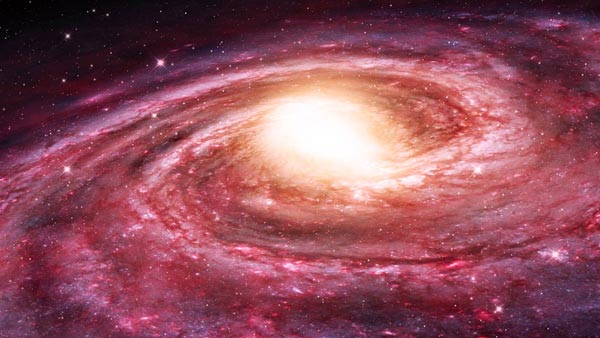Milky Way Ransacks Nearby Dwarf Galaxies, Stripping All Traces of Star-Forming Gas

Artist's impression of the Milky Way. Its hot halo appears to be stripping away the star-forming atomic hydrogen from its companion dwarf spheroidal galaxies. Credit: NRAO/AUI/NSF
These new radio observations, which are the highest sensitivity of their kind ever undertaken, reveal that within a well-defined boundary around our Galaxy, dwarf galaxies are completely devoid of hydrogen gas; beyond this point, dwarf galaxies are teeming with star-forming material.
The Milky Way Galaxy is actually the largest member of a compact clutch of galaxies that are bound together by gravity. Swarming around our home Galaxy is a menagerie of smaller dwarf galaxies, the smallest of which are the relatively nearby dwarf spheroidals, which may be the leftover building blocks of galaxy formation.
Further out are a number of similarly sized and slightly misshaped dwarf irregular galaxies, which are not gravitationally bound to the Milky Way and may be relative newcomers to our galactic neighborhood.
“Astronomers wondered if, after billions of years of interaction, the nearby dwarf spheroidal galaxies have all the same star-forming ‘stuff’ that we find in more distant dwarf galaxies,” said astronomer Kristine Spekkens, assistant professor at the Royal Military College of Canada and lead author on a paper published in the Astrophysical Journal Letters.
Previous studies have shown that the more distant dwarf irregular galaxies have large reservoirs of neutral hydrogen gas, the fuel for star formation. These past observations, however, were not sensitive enough to rule out the presence of this gas in the smallest dwarf spheroidal galaxies.
By bringing to bear the combined power of the GBT (the world’s largest fully steerable radio telescope) and other giant telescopes from around the world, Spekkens and her team were able to probe the dwarf galaxies that have been swarming around the Milky Way for billions of years for tiny amounts of atomic hydrogen.
“What we found is that there is a clear break, a point near our home Galaxy where dwarf galaxies are completely devoid of any traces of neutral atomic hydrogen,” noted Spekkens. Beyond this point, which extends approximately 1,000 light-years from the edge of the Milky Way’s star-filled disk to a point that is thought to coincide with the edge of its dark matter distribution, dwarf spheroidals become vanishingly rare while their gas-rich, dwarf irregular counterparts flourish.
There are many ways that larger, mature galaxies can lose their star-forming material, but this is mostly tied to furious star formation or powerful jets of material driven by supermassive black holes. The dwarf galaxies that orbit the Milky Way contain neither of these energetic processes. They are, however, susceptible to the broader influences of the Milky Way, which itself resides within an extended, diffuse halo of hot hydrogen plasma.
The researchers believe that, up to a certain distance from the galactic disk, this halo is dense enough to affect the composition of dwarf galaxies. Within this “danger zone,” the pressure created by the million-mile-per-hour orbital velocities of the dwarf spheroidals can actually strip away any detectable traces of neutral hydrogen. The Milky Way thus shuts down star formation in its smallest neighbors.
“These observations therefore reveal a great deal about size of the hot halo and about how companions orbit the Milky Way,” concludes Spekkens.
The National Radio Astronomy Observatory is a facility of the National Science Foundation, operated under cooperative agreement by Associated Universities, Inc.
Contact: Charles E. Blue, Public Information Officer
(434) 296-0314; cblue@nrao.edu
Media Contact
All latest news from the category: Physics and Astronomy
This area deals with the fundamental laws and building blocks of nature and how they interact, the properties and the behavior of matter, and research into space and time and their structures.
innovations-report provides in-depth reports and articles on subjects such as astrophysics, laser technologies, nuclear, quantum, particle and solid-state physics, nanotechnologies, planetary research and findings (Mars, Venus) and developments related to the Hubble Telescope.
Newest articles

Sea slugs inspire highly stretchable biomedical sensor
USC Viterbi School of Engineering researcher Hangbo Zhao presents findings on highly stretchable and customizable microneedles for application in fields including neuroscience, tissue engineering, and wearable bioelectronics. The revolution in…

Twisting and binding matter waves with photons in a cavity
Precisely measuring the energy states of individual atoms has been a historical challenge for physicists due to atomic recoil. When an atom interacts with a photon, the atom “recoils” in…

Nanotubes, nanoparticles, and antibodies detect tiny amounts of fentanyl
New sensor is six orders of magnitude more sensitive than the next best thing. A research team at Pitt led by Alexander Star, a chemistry professor in the Kenneth P. Dietrich…





















